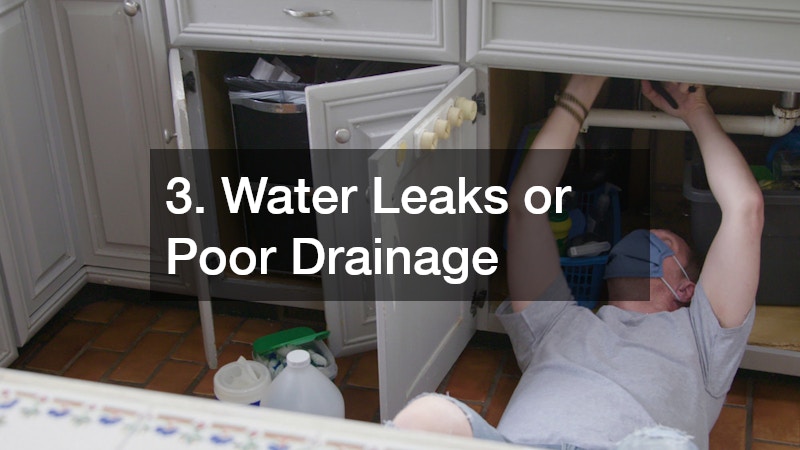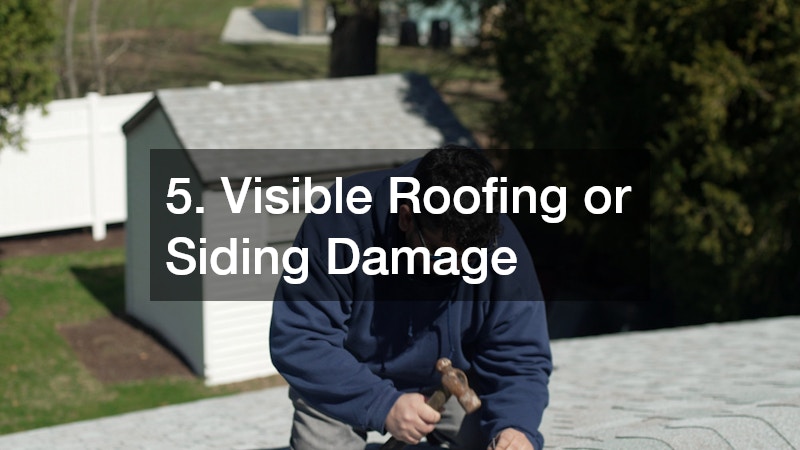Your home’s systems work quietly in the background to maintain comfort, safety, and energy efficiency. From heating and cooling to electrical, plumbing, and roofing, every component contributes to a safe and livable environment. Yet, these systems are often overlooked until something fails. Ignoring early warning signs can lead to costly repairs, energy waste, and uncomfortable living conditions, especially during harsh weather months.
Recognizing subtle changes in your home’s environment—such as unusual sounds from vents, fluctuating temperatures in different rooms, or visual cues like damaged shingles or warped siding—can alert homeowners to underlying issues before they escalate. These early signs often precede system failures that could compromise comfort, safety, and energy efficiency. Ignoring these indicators can lead to emergency repairs, higher utility bills, and even hazardous living conditions during extreme weather.
This guide highlights ten key warning signs that suggest your home systems may be at risk. Each sign is paired with insights into the type of professional intervention required. HVAC contractors can address inconsistent heating or cooling and detect problems with furnace services or air conditioning units. Plumbing companies handle leaks, clogs, and water damage, preventing mold growth and structural deterioration. Local electricians identify faulty wiring, unusual sparks, or overloaded circuits that pose fire risks. Roofing specialists, including local roofers and metal roofing experts, ensure that your exterior envelope is secure, preventing drafts, water intrusion, and energy loss.
By understanding and addressing these warning signs early, homeowners safeguard both their property and their comfort. Timely inspections, preventive maintenance, and professional repairs not only extend the life of home systems but also provide peace of mind. Proactive management helps avoid unexpected breakdowns that could leave you exposed to cold temperatures or costly emergency repairs, ensuring that your home remains safe, efficient, and comfortable year-round.
1. Uneven Heating or Cooling

When certain rooms feel warmer or colder than the rest of your home, it signals that your heating or cooling system is underperforming. Airflow imbalances, blocked ducts, or failing furnace components can lead to these temperature inconsistencies. If left unaddressed, the system works harder, raising energy bills and increasing wear on critical parts.
Engaging a licensed HVAC contractor to evaluate your system ensures optimal airflow and performance. Furnace services, such as cleaning, inspection, and component replacement, restore even heating, while regular air conditioning maintenance ensures your cooling system can manage summer peaks efficiently. Addressing uneven heating and cooling early prevents small inefficiencies from escalating into costly, emergency repairs.
Additionally, homeowners should monitor thermostat performance and check vents regularly. Clogged or obstructed vents, as well as dirty filters, can worsen temperature differences. Minor adjustments, combined with professional care, make a significant difference in home comfort and system longevity.
2. Strange Noises From Heating or Cooling Systems
Unusual sounds like squealing, grinding, or banging indicate mechanical stress or failing components. For example, motors may be misaligned, belts could be worn, or fans may encounter obstruction. Ignoring these noises can lead to system breakdowns or secondary damage to other parts.
Hiring an HVAC contractor ensures a thorough inspection of your air conditioning and furnace units. Professionals can lubricate moving parts, replace failing belts, and adjust misaligned motors. Regular furnace services maintain proper performance and prevent unexpected failures.
Homeowners can also perform simple monitoring at home. Listening for subtle changes in sound and noting patterns in usage helps professionals pinpoint issues more effectively. Early intervention not only extends system life but also reduces the risk of emergency service calls, providing peace of mind through the winter and summer months.
3. Water Leaks or Poor Drainage

Pooled water, persistent dampness, or slow-draining sinks and showers often signal plumbing issues that, if left unaddressed, can quickly escalate into serious problems. Even minor leaks can compromise walls, floors, and ceilings, leading to water stains, warped surfaces, and weakened structural components. Prolonged exposure to moisture also creates an ideal environment for mold and mildew growth, which poses health risks and can be costly to remediate.
Engaging a professional plumbing company ensures that both visible and hidden issues are addressed effectively. Experienced plumbers can perform comprehensive inspections, detect leaks behind walls or under floors, and repair compromised pipes before they cause extensive damage. Services may also include sewer line assessments, water heater maintenance, and drain cleaning, all of which help maintain efficient water flow and prevent clogs or backups.
Homeowners can support professional interventions through regular monitoring and minor preventative actions. Checking faucet seals, observing for unusual noises in pipes, and paying attention to changes in water pressure can reveal early signs of trouble. Additionally, keeping an eye on water bills for unexpected spikes may indicate hidden leaks or inefficiencies.
4. Frequent Temperature Fluctuations
Inconsistent home temperatures can result from malfunctioning air conditioning units, failing furnace components, or air leaks in the ductwork. Frequent cycling, sudden hot or cold spots, and uneven heating or cooling force systems to operate inefficiently, raising energy costs.
An HVAC contractor can conduct comprehensive diagnostics to identify failing components and restore even climate control. Furnace services, such as blower maintenance or heat exchanger inspections, are essential to consistent heating. Similarly, air conditioning inspections ensure the system maintains cool, consistent airflow.
Simple homeowner actions can complement professional services. Checking and replacing air filters, sealing visible leaks around vents, and ensuring unobstructed airflow help maintain comfort and efficiency. Combining proactive observation with professional intervention reduces system strain and prolongs equipment lifespan.
5. Visible Roofing or Siding Damage

Cracked, missing, or warped shingles and siding are more than aesthetic issues—they compromise your home’s insulation, structural integrity, and protection against weather. Leaks from roof damage or gaps in siding allow water intrusion, drafts, and potential pest entry, leading to more extensive repairs if left unchecked.
A local roofer can perform thorough inspections and repair or replace damaged materials, while siding contractors can restore protective barriers on walls. For properties with metal roofing, specialized maintenance ensures resistance to rust, corrosion, and water infiltration.
Addressing these issues proactively preserves energy efficiency, prevents interior damage, and maintains the overall value of your home. Regular visual inspections, particularly after storms, combined with professional maintenance, ensure the longevity of roofing and siding systems.
6. Unusual Electrical Activity
Flickering lights, frequently tripped breakers, or non-functioning outlets indicate potential electrical problems. Overloaded circuits, damaged wiring, or aging panels can compromise safety and lead to fire hazards.
Local electricians provide inspections, troubleshooting, and repairs to address these risks. Updating wiring, replacing faulty outlets, and ensuring panels meet current safety codes prevents emergencies and protects home systems.
Homeowners should also monitor devices for inconsistent operation and avoid overloading circuits. Combining homeowner vigilance with professional service ensures that electrical systems remain reliable and safe for daily use.
7. Reduced Efficiency of Solar Panels
For homeowners with solar panels, a drop in energy production is an early warning sign of potential issues. Debris accumulation, damaged wiring, or faulty inverters can significantly reduce energy output.
Licensed technicians can inspect solar panels, clean surfaces, check mounts, and repair any minor electrical issues. Routine maintenance ensures your system operates at peak efficiency and supports energy savings.
Regular monitoring of energy output alongside periodic inspections allows homeowners to identify problems before they become major expenses. Keeping solar panels clean and free from obstructions ensures long-term performance and maximizes the return on your sustainable energy investment.
8. Drafts or Insulation Issues
Cold drafts, uneven heating, or condensation along walls and windows are often clear indicators that a home’s insulation or sealing is compromised. These issues not only reduce comfort but also place additional strain on heating and cooling systems, driving up energy costs. Over time, persistent air leaks can lead to uneven temperatures, higher utility bills, and even increased wear on furnace services and air conditioning units. Moisture accumulation from poorly sealed areas can also contribute to mold growth, wood rot, and damage to wall finishes.
Infrared inspection technology provides a powerful tool for detecting hidden gaps in insulation, leaks around windows and doors, and areas of moisture intrusion that may not be visible to the naked eye. Licensed contractors, such as local siding companies, can assess the exterior envelope of the home, recommending solutions like sealing cracks, adding additional insulation, or upgrading windows and doors to improve energy efficiency. Even small interventions, such as weatherstripping or caulking, can significantly reduce drafts and stabilize indoor temperatures.
Proactive attention to insulation not only enhances comfort but also protects the long-term performance of home systems. Addressing issues early prevents costly repairs to walls, flooring, and HVAC equipment while improving energy efficiency. Regular seasonal inspections, particularly before winter and summer, ensure that any changes in performance are noticed promptly. By combining infrared assessments, professional repairs, and ongoing monitoring, homeowners can maintain a cozy, energy-efficient, and resilient home while reducing strain on heating and cooling systems.
9. Strange Odors or Gas Smells

Unusual smells in vents, near appliances, or emanating from plumbing fixtures are often early warning signs that something is amiss in a home’s essential systems. Musty or damp odors can indicate hidden water leaks, mold growth, or clogged drains, while burning or metallic scents may point to overheating electrical components or failing HVAC equipment. Gas odors, even faint ones, represent immediate safety hazards and require urgent attention to prevent potential explosions, carbon monoxide exposure, or fire risks.
Engaging qualified professionals such as HVAC contractors, plumbing companies, and local electricians is critical when unusual odors appear. These experts can perform thorough inspections to identify the source, assess potential risks, and implement repairs safely. Furnace services, including vent and duct inspections, help maintain proper airflow, eliminate trapped contaminants, and prevent the accumulation of harmful gases. Likewise, plumbing companies can trace leaks or blockages in water and sewer lines that may contribute to unpleasant smells or long-term water damage.
Homeowners should treat unusual smells as early warning signals rather than minor annoyances. Prompt reporting and professional intervention not only protect the household from health and safety hazards but also prevent minor issues from escalating into costly repairs. Regular inspections, combined with attentive monitoring for strange odors, are key components of a proactive maintenance strategy. By acting quickly, homeowners ensure that all home systems continue to function efficiently, maintain indoor air quality, and provide a safe, comfortable living environment year-round.
10. Frequent System Breakdowns
Homes requiring repeated repairs across heating, cooling, plumbing, or electrical systems often reveal signs of aging infrastructure, improper installation, or deferred maintenance. These recurring issues not only create daily inconveniences but also escalate repair costs and can leave families vulnerable during extreme weather conditions, when reliable systems are most critical. Ignoring small problems can allow them to compound, leading to emergency breakdowns that disrupt household routines and increase stress.
Engaging experienced professionals such as HVAC contractors, plumbing companies, local electricians, and roofing specialists provides a long-term solution. These experts can evaluate the root cause of recurring failures, recommend preventive maintenance plans, and perform timely repairs or system upgrades to restore reliability. Coordinating inspections across critical systems—including furnace services, air conditioning units, solar panels, and roofing—ensures that every component functions efficiently and that potential issues are caught before they escalate.
Consistent monitoring by homeowners, combined with scheduled service calls, allows small anomalies to be addressed promptly. For example, tracking energy usage, monitoring water pressure, and observing unusual sounds or odors can provide early warnings. Professionals can then act quickly, applying corrective measures that maintain optimal performance and prolong system life.
Recognizing early warning signs—such as uneven temperatures, frequent cycling, strange noises, leaks, drafts, or intermittent functionality—is key to preventing more serious problems. Partnering with licensed HVAC contractors, local electricians, plumbing companies, and local roofers ensures expert diagnosis, accurate repairs, and proper system calibration. Infrared inspections, furnace tune-ups, and regular solar panel maintenance are additional strategies that safeguard performance and prevent costly failures.
Ultimately, proactive attention to home systems preserves both financial investment and household comfort. Establishing a routine maintenance schedule, staying attentive to small issues, and engaging qualified professionals creates a resilient home environment. By addressing problems early, homeowners can avoid emergency situations, reduce stress, and maintain consistent comfort, efficiency, and safety throughout the year. This integrated approach ensures that your home’s essential systems remain dependable and capable of supporting your family’s daily needs, no matter the season.
